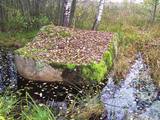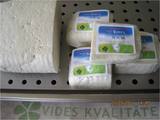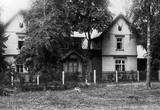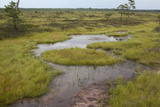| Nr | Name | Beschreibung |
|---|---|---|
|
Platais Boulder (Wide boulder). You can find it in the rural municipality of Mākoņkalns not far from a
small meadow close to the boulder of Āžmugura. Both the boulders have their legends. Some say that the
boulder of Āžmugura is the part of Platais boulder and the rainwater from its cavity heals the warts.
|
||
|
The memorial site with a 1936 monument produced by the sculptor Kārlis Zāle is located in Smārde near the Smārde-Tukums road. It commemorates 38 soldiers who fell during World War I. Between 1915 and 1917, the front line was near Smārde. Many men were killed, and they were buried at the local swamp. It was only after the war that they were reburied in Smārde, Kūdra, Ķemeri, and Sloka. |
||
|
Hiiu Gourmet ir mazs uzņēmums, kura mērķis ir piedāvāt produktus no vietējām izejvielām Hījumā. Izstrādājumi tiek izgatavoti ar rokām mazos daudzumos. Produktu klāstā ir mājās gatavoti sīrupi, piedevas, sinepes utt. No augiem un ogām, kas novāktas Hījumā mežos. Saimniece Heli padāvā Hījumā tradicionālā ēdiena gatavošanas meistarklases. |
||
|
Die dritlängste (in seiner Zeit auch eine der modernsten Brücken) Backsteinbrücke Europas (164 m), gebaut 1873 – 1874. |
||
|
Целостное здание церкви строилось в 1780 – 1781 гг. во времена барона Х.Ф. Бера, а перестраивалось в 1876 и 1888 гг. Церковь известна своим алтарем и кафедрой, выполненными в стиле рококо, и построенным в первой половине XVIII века органом. Церковь можно осмотреть изнутри. |
||
|
Это поездка предназначена для компании друзей или рабочего коллектива, желающих как активно провести выходные, так и узнать о кулинарном наследии Курземе и попробовать экологически чистые продуты. Во время поездки Вы в сопровождении гида и при свете факелов изведаете Северные форты Военного городка Лиепаи, ознакомитесь с разнообразием побережья Балтийского моря и увидите леса Шлитере с высоты птичьего полета с маяка Овишу. На второй день Вы можете пройтись пешком по двум природным тропам, что будет как полезно для здоровья, так и познавательно. |
||
|
Atrodas Burtnieka ezera austrumu krastā – uz ezera poldera dambja. Pavasara un rudens migrāciju laikā – laba putnu vērošanas vieta. Putni redzami ne tikai ezera piekrastē, bet arī poldera mitrajās pļavās. |
||
|
Die Inseln Saaremaa and Hiiumaa sind die größten von den 1500 estnischen Inseln. Eigentlich ist der Name Saaremaa der gemeinsame Name für die Inseln Muhu und Saaremaa, die mit einer Dammstraße wie Hiiumaa und Kassari verbunden sind. |
||
|
Exkursionen zum Hof. Man kann Ziegen, Pferde, Kaninchen, Hausgeflügel und Haustiere anschauen. Die Besucher können sich auch fürs therapeutische Reiten anmelden, Pferd reiten, Ponyreiten oder mit einer Pferdekutsche fahren. Erwerb von Ziegenmilchprodukten: Milch, Käse, Quark, Kefir und Joghurt. |
||
|
Das Bistro befindet sich 130 m von der Kreuzung von Berzkrogs (gegenüber der Tankstelle Statoil). Es unterstützt lokale Produzenten, deren hergestellten Produkte (auch Souvenirs) man hier genießen oder kaufen kann. Lettische Küche: Graue Erbsen mit Speck, Gerstengrütze. |
||
|
Die Kräuterfarm Ööbiku, die sich in einer ökologisch reinen Gegend befindet, befasst sich mit dem biologischen Anbau von Kräutern, Beeren und Gemüse sowie deren Weiterverarbeitung. Hier werden auch Wurzelgemüse, Obst und Beeren getrocknet. |
||
|
Lietuvas lielākais sūnu purvs, kura aizsardzības nolūkā ir izveidots Čepkeļu dabas rezervāts (Čepeklių gmatinis rezervatas). Tas izvietojies starp Dzūkijas nacionālā parka dienvidaustrumu daļu un Baltkrieviju. No Marcinkones pa smilšainu meža ceļu (~ 9 km turp - atpakaļ) ar kājām vai divriteni (arī nelielu tūrisma autobusu līdz 20 vietām) var nokļūt līdz purva malai, kur mežainās kāpās un purvā izveidota 1,5 km gara dabas taka un skatu tornis, no kura labi pārredzama purva rietumdaļa. Pirms došanās uz Čepkeļu purvu, ir jāreģistrējas Dzūkijas nacionālā parka apmeklētāju centrā (Šilagėlių gatve 11), kas meklējams aiz dzelzceļa pārbrauktuves. Te apskatāma neliela nacionālajam parkam un rezervātam veltīta ekspozīcija. |
||
|
Das Café befindet sich im historischen Zentrum von Tukums. Hier werden köstliche lettische Leckereien angeboten: Brötchen, Blechkuchen und Piroggen. |
||
|
The former name of the house was “Forstei” (Forester’s House). It was built using logs of the old Bīriņi Castle. The first owner of the building was Alexander Alexei von Pistohlkors, the baron of Bīriņi Manor. It used to be a house of the manor’s chief forester Pauls Moltrehts. The building served as the chief forester’s work place and residence, as well as the Manor’s hunting base. The building was rebuilt several times. It obtained its current appearance and also the symbolic deer antlers in 1891. During the times of the Independent State of Latvia the house obtained a Latvian name – “Meža māja” or “Forest House”. Ownership of the house has repeatedly changed. In the 1930s, the house became a recreation place for cultural professionals and artists. In 1937, the composer Alfrēds Kalniņš spent the summer in the house working on an interpretation of the score for the second staging of the first Latvian opera “Baņuta”. During the post-war period – from 1945 to 1956 – the building housed Saulkrasti Village Council, and during the times of Saulkrasti District it was the location of the People’s Education Department. Later the children’s sanatorium “Ugunskurs” was transferred from Jūrmala to this building and was renamed “Saulkrasti Children’s sanatorium”. Now the building is privately owned. |
||
|
Aus dem Wacholder, der als Symbol der Insel Saaremaa gilt, wird auch ein wertvoller Sirup hergestellt. Die Gäste werden vieles über Wacholder erfahren. Von Frühling bis Herbst kann man die Pracht des Gartens genießen und das alte Bauernhaus besichtigen. |
||
|
Die Angaben darüber, dass die Liven den orthodoxen Glauben angenommen haben, beweist eine Urkunde, die in den 1990er Jahren während der Restaurationsarbeiten im Turm der evangelisch-lutherischen Kirche (siehe auch weiter) gefunden und dort beim Bau der Kirche im Jahr 1885 hineingelegt wurde. Diese Urkunde erzählt, dass der Übertritt der Liven zum orthodoxen Glauben, dem sogenannten Glauben des Kaisers, „nicht mit der Glaubensüberzeugung verbunden ist, aber das ist ein Mittel, wie man an Vorteile für Grundstücke und an Genüsse gelangen kann.” Die orthodoxe Gemeinde hat schon im Jahr 1885 ein Grundstück vom Baron Osten-Sacken gekauft, auf dem im Jahr 1890 die Kirche, das Priesterhaus und ein Schulgebäude gebaut wurde. Alle Gebäude haben sich bis heute erhalten. Die Kirche hat ihre eigene Gemeinde und die Gottesdienste werden hier einmal im Monat abgehalten. Man kann Angaben darüber finden, dass Kolka das einzige Dorf an der livischen Küste ist, wo in den 1890er Jahren eine orthodoxe Kirche gebaut wurde. Die Glocke hat ihren Platz im Jahr 1936 gefunden. Während der Sowjetzeit wurde die Kirche als eine Leichenhalle benutzt, aber dient sie ihrem ursprünglichen Ziel. |
||
|
Ein Abschnitt der Schmalspurbahnlinie mit Spurbreite 750 mm, der Alūksne un Gulbene verbindet ist in Teil der ehemaligen Eisenbahnlinie Stukmaņi – Valka. Zurzeit ist es die einzige Schmalspurbahn mit ständigem Personenverkehr in Lettland, die noch im Betrieb ist. Die Bānītis fährt jeden Tag. Ein im Südteil der Stadt Alūksne gebautes Stationsgebäude wurde 1903 eröffnet. Die Linie ist 33 km lang und hat 10 Stationen und Haltepunkte. Die Fahrt mit der Bānītis dauert ~ eineinhalb Stunden. Populär ist ein jährliches Fest der Schmalspurbahn Alūksne – Gulbene, zu dem viele Gäste kommen. |
||
|
Hierbei handelt es sich um einen ökologischen biodynamischen Hof, der zwei Schwestern gehört und der ganz Heilkräutern und Gewürzen gewidmet ist, aus denen Kräutertees und Würzmischungen hergestellt werden. Bei der Führung werden Einzelheiten zu den angebauten Pflanzen und deren pharmakologischen Eigenschaften erwähnt und die Pflanzen gezeigt. Im Hof kann man zudem Fahrräder ausleihen und auf Radwegen den Nationalpark Niederlitauen erkunden. |
||
|
Very wide territory for a nature restricted area where extensive forests and several bogs can be found. The territory is important living space for many bird species. Vasenieku bog path with observation tower is the most attractive sites of the restricted area and offers unique landscape of the bog for its visitors. Waterproof shoes are recommended for visitors as the first 500 m of the path is molded turf rampart. Information stands are significant source of information along the path. It is suggested to visit also Stikli (Glass) village where glass factory used to be. Chandelier of Stende church has been made in this factory (by memory of Inese Roze).
|
||
|
Alises Zariņas bioloģiskā saimniecība nodarbojas ar kazkopību. Pašlaik ir divdesmit slaucamas kazas un no to svaigi slauktā piena tiek gatavots siers. Saimniecība dibināta 2015. gadā. |
||























